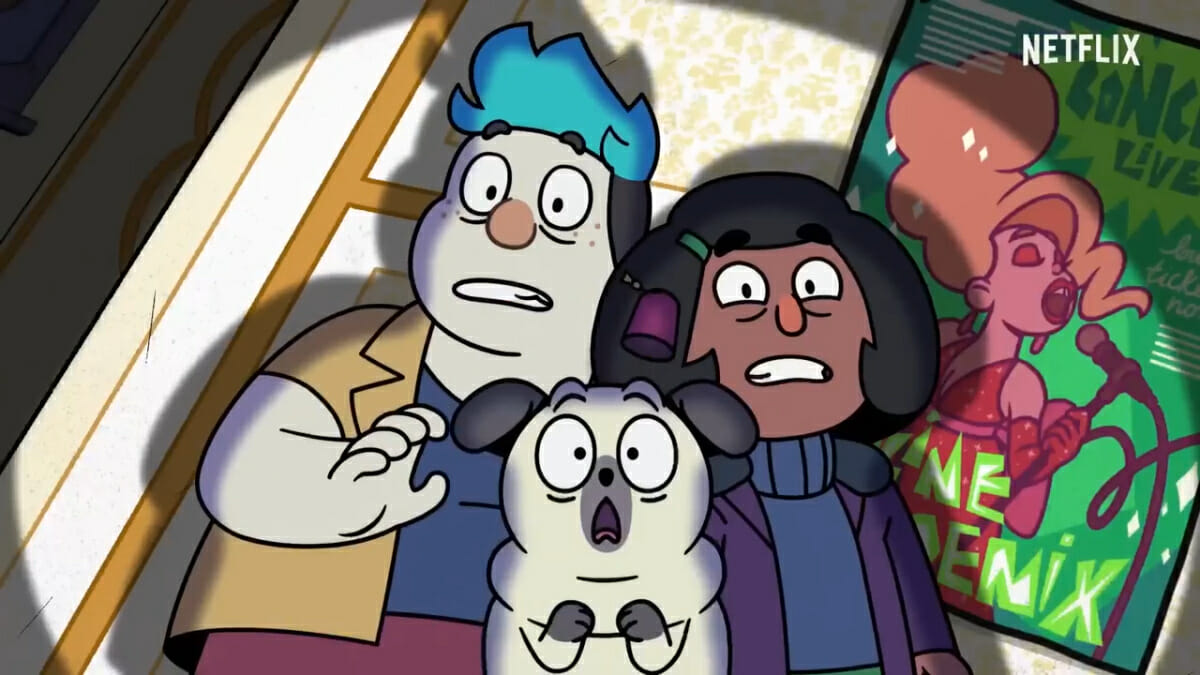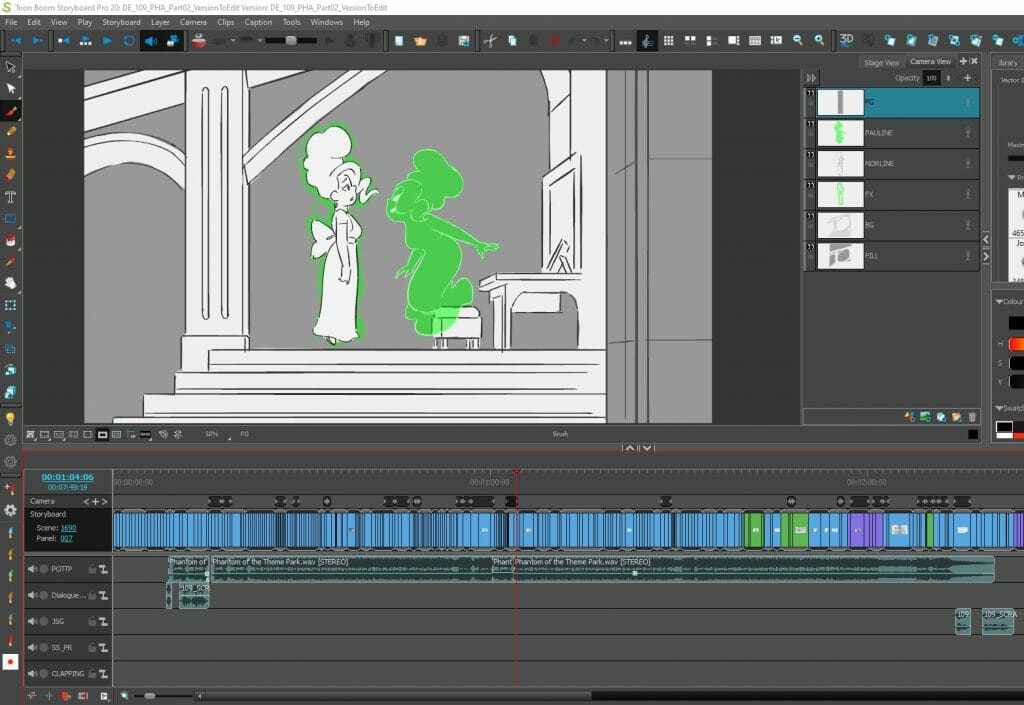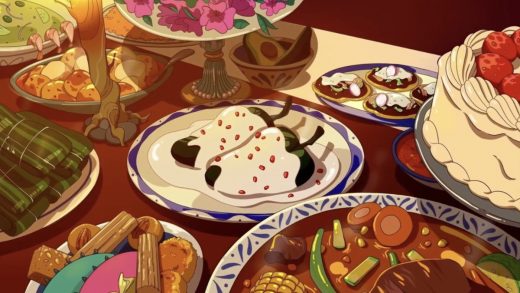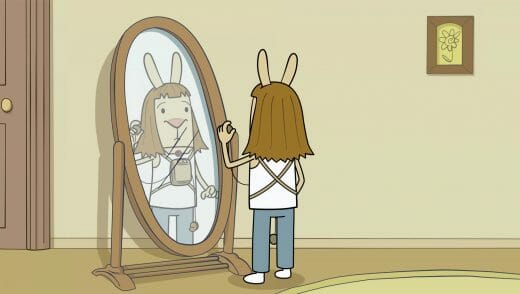
London-based Blink Industries produced Netflix’s recent horror-comedy animated series Dead End: Paranormal Park. The show, now streaming its second season, is an adaptation of series creator Hamish Steele’s graphic novel series DeadEndia. The comics were first adapted into a Cartoon Hangover short, which sparked the initial interest in the project for many members of the team. Both the original comics and the animated series have been lauded by critics for their representation of queer, neurodiverse and racially diverse characters.
We caught up with Althea Aseoche (story artist), Plamen Ananiev (lead rigging artist), and Joe Sutherland (animation director) to discuss the process behind adapting a graphic novel for the small screen, animating diverse characters authentically, and the future potential for horror in animation.
How familiar was the crew with the DeadEndia comic and the Cartoon Hangover short before starting production?
Joe: I think a lot of the crew were aware. As soon as Blink Industries could say the name of what they were hiring for, that’s when the applications started coming in. I hadn’t read the comics. I’ve read them now, but I hadn’t at the time. However I’d watched the short and I was excited to work on it.
Plamen: I hadn’t read the comics. I could see the short, so I had some idea of what it was going to be. I bought the comics before I started. And I really love them!
Althea: Throughout the process I was mostly just in touch with our story team, so I can only speak for us. While we were working on the series, some of the team had read the comics, others didn’t. It wasn’t necessary to know the original source material; the series was very different to the graphic novels in many aspects. But those of us who did read them got to geek out over seeing graphic novel plots emerging in the series we were creating. And could then discuss the similarities and differences.
How did your team approach adapting the comic characters for a television series?
Joe: The heavy-lifting was done in script, pre-production and design. Since they were the departments figuring out how to translate it to a more series-based format.
Plamen: It was mainly determined by Hamish, the showrunner, and Design. Then the designs were tweaked, alongside animators, to make them more animation-friendly — plus to keep the general style they wanted to go for. Mostly it came from the character design team.
Althea: Hamish and his writing team did a lot of the ground work for us! The scripts we were given provided us with a lot of what we needed. If we had any questions, Hamish was always there to give answers and discuss ideas with us. The characters do depart a fair bit from their comic iterations, so it was more important for us to know their series personalities and traits.
How has working on a Netflix series differed from working on a project for a network?
Plamen: We did get a lot of freedom on how we wanted to do things. Hamish Steele had a lot of freedom on the characters and stories. Netflix was really supportive of the production.
Althea: I have a feeling there were less notes overall compared to working with other networks! To be honest, Liz Whitaker (our director), Adrian Maganza (head of story), our revisionists team and the editing team would probably know more about the network notes than I would, as they were in the front lines for addressing those notes.
Joe: They seemed to be more open to creative input and of course the themes running throughout the show. But, most importantly, they allowed us to portray emotions that didn’t just fall under the bracket of happy and sad. We could explore more nuanced character traits.
What can animation bring to the horror genre?
Althea: I would actually say there are actually quite a few animated horror series out there. In recent years we’ve seen a number of anime-style horror series for adults like Castlevania or Trese emerge from outside of Japan. If we’re talking kids series there’s plenty with horror inspired elements — series about witches, ghosts, vampires.. Thinking back to my childhood, I remember watching Funny Bones, Trap Door and Aaahh!! Real Monsters on TV.
Plamen: With live action, a lot of the time, because of the CGI, it’s a bit jarring because you have two very different things interacting. It kind of kills the creepiness a bit. Even though animation isn’t real, you have two things that are in the same world interacting, which I think helps sell it.
Joe: Well, animation is sort of limitless, isn’t it? You can do whatever you want, you can create whatever you want. In that aspect, you can create these horror worlds, these fantasy worlds, that really allow the imagination to run wild.
I wasn’t sure that 2D animation could actually be that scary. I went in like: “It’s going to be spooky, but not scary.” But then when you’re watching some of the episodes back, you see some stuff that’s actually quite creepy and frightening. We did sell horror, to some degree.
Althea: There’s so many possibilities using animation as a medium of storytelling. Animation can be playful. It can run with a style then choose to turn that on its head. In the third episode of Dead End: Paranormal Park, ‘Trust Me,’ we see a very different animation style for Norma’s fear world. Shapes are warped, the outlines are distressed, a visual metaphor for how she experiences the real world. Norma uses her fears to defeat the monster and save the day too. It’s important for kids, and adults too, to be able to watch their heroes face and overcome adversaries.
The comics and the series have both been lauded for their queer, neurodiverse and racially diverse characters. How did you make these portrayals feel accurate or authentic?
Joe: A lot of it comes down to the writing, storyboards and Hamish’s ideas. They put a lot of development and research in, as well as their own life experiences. Additionally, in animation, the only contributions we could really make were subtle character traits within the acting. For example, with Norma being on the neurodiverse spectrum, she wouldn’t make eye contact with people all the time. And physical contact was less likely. Of course it’s a different experience for everyone, but that’s the way Norma was portrayed.
Plamen: A lot of thought went into selling that idea. And making it feel natural and part of the show. Things are kept very subtle, but also clearly supporting the idea of who the characters are. A lot of it comes from the writing, the animation itself and the storyboards.
Althea: A lot of credit goes to Hamish and his amazing and diverse writing team. They did a lot of the groundwork for us, crafted the stories and built these characters. They also made sure to check their scripts with consultants.
For me, personally, my family was originally from the Philippines and I grew up in Sydney, Australia. The thing that absolutely wowed me when I read the DeadEndia comics was how much the group of characters resembled the group of friends I grew up with. Okay, I didn’t have a talking dog wizard or a Courtney in that friend group, but that would have been great fun! I immediately connected with DeadEndia because of the racial diversity. I’m not sure if my lived experience contributed in any way to my work on the show, but I think my emotional connection to the story and these characters did drive me to do the best work I could for the series.
How would you describe the animation techniques used on the series?
Joe: We used a snappy, pose-to-pose technique which looked stylized but was also beneficial time wise. Usually less frames means less work is involved at the in-between and retakes stage. This resulted in a style that stayed true to the graphic approach of the designs, whilst being beneficial in terms of deadlines on the production.

What was the most interesting or challenging scenes to animate?
Joe: Besides the entire series being challenging due to us trying to push the boundaries of UK-based rigged animation, I think a specific challenge was the emotional acting side of the animation. It’s always easy to get cliche. We didn’t want them to be that. They had to be more natural. For example, subtle eye movements could really portray what the characters were thinking or feeling without going over the top. Less is more.
And then some might say the action was the most challenging, because you’ve got really extreme poses and the animation is more complex. On top of this, there was also traditional animation in there at times — which adds a whole other level. Luckily we had some really talented people who could also do that.
I would say the most interesting scenes were the emotional ones. There’s a sequence in particular in Season 1, Episode 6, where Barney eats in the saloon with his family and his parents just are not understanding. It happens over a whole episode. To keep that consistent throughout the episode was a challenge, because at times the acting was so subtle and the tension had to build over scenes.
What did the storyboarding stage of this project look like?
Althea: I think we had about fourteen story artists, including our head of story and revisionists, throughout the two seasons. The entire production took place during the pandemic so we were all working remotely. We kept in touch over Slack and video meetings. The software we used for storyboarding was Storyboard Pro.
We were given 3 weeks to do our first pass. My board partners and I checked in with each other regularly, at least once a week, just to make sure our storyboard parts hooked up where they needed to. After the first pass, we would do an internal virtual pitch to Hamish Steele (showrunner), Liz Whitaker (director) and storyboard supervisor for the episode — this could be Adrian Maganza (head of story) or Max Loubaresse (lead storyboard artist). After the pitch, we would receive general notes from Hamish and Liz.
Once pass two is ready, we would do a second virtual pitch. This time it would be recorded for Netflix to watch or in some cases they would attend the pitch. After the pitch, Hamish and Liz would again give their notes and reactions. Usually there wouldn’t be too many, and we were given a few days to address these before delivering the episode to edit.

Was making a musical episode challenging?
Althea: Ultimately, storyboarding a musical is still a storyboarding task. The difference is, the character is singing out loud what’s on their mind or how they are feeling. Usually storyboarders say ‘show, don’t tell’ but in this case, sometimes the character is telling because they’re singing it out loud! So what else can you show visually to enhance the storytelling? Should you support what they are singing or should you contradict it? This was part of my thought process.
What helped a lot was that the musical episode was written purposefully to be the penultimate episode. And, as Hamish briefed it to us, the emotional climax for our main characters. All the songs had stories embedded in them so we had a head start with our musical storyboards having meaningful storytelling.
Plamen: It wasn’t more challenging than any other episodes for the rigging team because a lot of the rigs used were pretty much already made and could be reused from other episodes. The general complexity of rigs on the show was fairly high, so that they can do all the weird poses that they need to be doing.
Joe: The challenge for the animators was that we weren’t just working to emotional beats, we were working to timing and music beats. That was something that everybody had to take into account when doing the musical. It’s the main episode that everyone wants to watch and talk about later. There’s a lot of pressure to make every scene look amazing because it’s the musical episode.
How would you describe the techniques used to rig the characters in Toon Boom Harmony?
Plamen: With the show, we had a mix of techniques. The main character rigs were probably the most complex ones where they can do almost anything they needed to do, with some smaller sections where there were hand-drawn bits. We knew in advance that there would be some hand-drawn parts, so we built a system to support that and allow animators to switch parts of the rig quickly on and off and just draw them in.
For a lot of the monster rigs that look really complicated in terms of design: they’re actually really simple rigs because we were working with the board and animation teams to make them look good for the shot. And not make a very complicated rig for something that doesn’t need to be. We ended up doing a lot of bespoke, simple rigs for particular shots, so we could make sure that they’re detailed and they look good, but also that they’re pretty light.
Which character was the most interesting or challenging to rig?
Plamen: Pugsley (the dog) was probably the most interesting one just because he goes between being on all fours and up on two legs. We kind of built two rigs in one, so he can do both. I enjoyed problem-solving that. Hopefully that worked out for animation as well when they used it.
Then, there were some other ones. There are characters with four arms. There are all sorts of weird designs that we had to adapt to and rig. But from my point of view, Pugsley was my favourite one.
- You can see more of Althea Aseoche’s work on her website and Instagram account. Plamen Ananiev can be reached via his LinkedIn account. Joe Sutherland can be found on Twitter and LinkedIn.
- Curious to see more of Dead End: Paranormal Park? The first two seasons of the series are currently streaming on Netflix.
- Interested in making Blink Industries your new haunt? Visit the studio’s website for current job opportunities.



